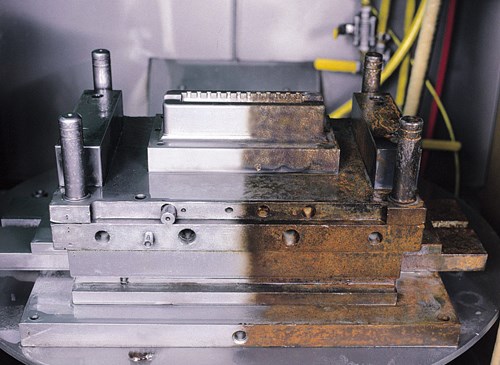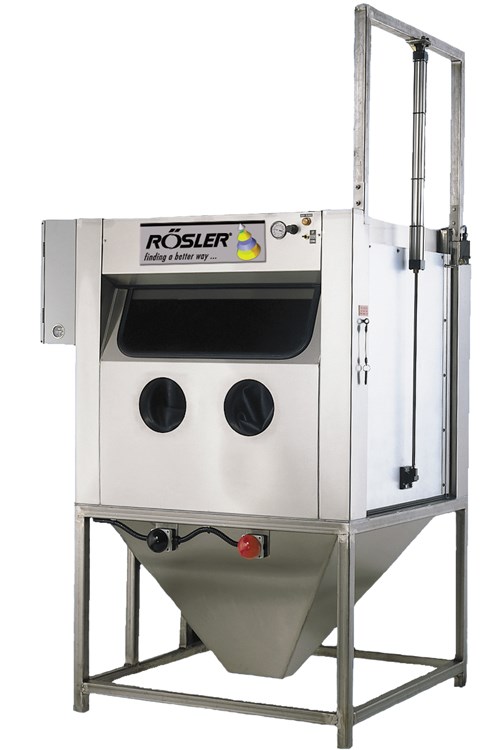Achieving Precision Surface Finishes with Slurry Blasting
Wet blasting is a dust-free and static-free process that removes burrs, scale, oxidation and rust, marks, paint and coatings, oils and grease while preparing the surface for other coatings or processes.
The concept of the wet blasting process is straight forward enough: Combine abrasive media with water to form a special slurry. Add regulated compressed air to control the pressure as it is discharged over a surface. It is a dust-free and static-free process that removes burrs, scale, oxidation and rust, marks, paint and coatings. It can also remove oils and grease while performing other functions, such as preparing the surface for other coatings or processes.
Today, matte finishes are a popular choice for parts—often for both practical and cosmetic reasons. Automated slurry-blasting machines are a great choice for achieving these fine, non-directional matte finishes in a single operation. Depending on the application, profiles of less than 4 Ra are possible, and users can choose from various media including glass beads, ceramic or plastics.
The slurry blasting brings a number of advantages to the finishing process. It virtually eliminates embedded media issues commonly found in dry blasting systems. The water and slurry are recirculated, requiring no drain hookup. The process does not create dust, and chemicals are not required, adding to its appeal for manufacturers committed to limiting their environmental impact.
However, finding the right slurry blasting equipment, as well as achieving and constantly maintaining the desired results, depends heavily on controlling and monitoring several specific machine functions. Ensuring consistency in terms of media, air and water pressure is critical to precise and consistent finish results. The following guide outlines key considerations and recommendations when selecting slurry blasting machines.
Part Fixturing
Finding a method to hold the part firmly and in a consistent position in the blast stream is essential and will require the end user and blast equipment vendor to work together in identifying the best solution. Part fixturing can be combined with masking techniques to protect surfaces not requiring a profile.
Control
Consideration should be given to the programmable logic controller (PLC) of the machine and the operator interface (HMI). This important aspect provides part process and machine parameter setup, as well as editing, and saves the parameters to form part process “recipes.”
Part processing is accomplished through enabling the assigned recipe number. The control system must monitor all machine parameters during the process cycle as well as machine shutdown and display status/fault on the HMI screen.
Machine Configurations
Consistent process results require that the developed part-to-blast-stream relationship be repeated cycle after cycle. There are several ways to control the process by manipulating the part. Most often the fixtured part rotates on a powered table with fixed nozzles targeting specific areas. The part can also be manipulated in front of blast streams with a robot, or a robot can manipulate the nozzles. In any machine configuration the part or nozzle movement must be monitored in real-time.
Part Rotation within the Blast Streams
Another significant feature of a control system is variable frequency drive (VFD). The drive should be external to the cabinet and use a belt and sheaves. In addition, a zero-speed sensor located on an idler sheave will confirm table rotation and help ensure even, consistent coverage.
Media Concentration Control
Low-level warning sensors for the slurry concentration are an important feature to ensure a precise and consistent result. If the media concentration falls below the set percentage, more media is automatically added from the hopper. The system should allow for roughly three additions of media, but if concentrations remain too low, the system should trigger a shutdown and display a warning.
Media Size Control
Media within the slurry must be the correct size. A hydrocyclone should be incorporated in the equipment to separate the slurry stream into two outlets: one with the fine particles and water and the second with the large particles (typically the remaining good media). The large particles are returned to the machine sump while the fines are sent to a vibratory classifying screener where a screen recaptures any good media and returns it to the sump. The remaining water and smaller particles are sent to the moving bead filter where the water is separated from the particles and recycled back into the system as rinse or make-up water.
Slurry Pump Flow
Water pressure should remain within ±3 psi. Water pressure sensors are an indirect, but effective way to ensure the slurry flow is being generated by the pump. In addition, if the slurry pressure exceeds the set tolerance, the sensor should trigger a machine shutdown and display a warning.
Startup and Continuing Slurry Agitation
To ensure that the media and water form a homogeneous solution that is ready for the blasting operation, slurry agitation must be initiated at startup, and the machine sump holding the water/media must continually agitate the slurry during the blast cycle. A pre-process agitation cycle provided by the machine supplier is also important, especially if the machine has not been operated for several hours.
Nozzle Pressure Control
Air pressure from the nozzle should remain within ± 1 psi. An automatic, proportional air valve is important to maintain the pressure programmed in the recipe and sent to the blast guns. This control process will shut down the machine and trigger a fault if the pressure falls out of tolerance.
Operator Viewing Window
For additional process verification and troubleshooting, a viewing window allows the operator to look into the blast cabinet and observe the blast cycle in operation.
Process Testing Apparatus
A method to test, process and confirm the correct nozzle-to-part relationship is also extremely important. Testing can be accomplished with laser light fixtures that fit into the nozzle orifice. The laser beam shows the blast stream’s target point on the part, making routine inspections, adjustments and fine tuning straight forward and repeatable.
Support
Finally, a factory-trained, local representative can provide quick, valuable support for the process equipment. Parts availability, preventive maintenance and trustworthy after-sales service go a long way in ensuring that process equipment and operations are running reliably and efficiently for providing precision matte finishes time after time.
— Rosler Metal Finishing USA, LLC
Read Next
Integrated Solutions for Chip Removal and Fluid Filtration
Shops can easily view chips simply as waste, hardly giving a second thought to the disposal process and the potential related savings. By keeping an eye on the waste and choosing the most efficient methods of chip disposal, a shop can easily add to the bottom line through substantial savings.
Read MoreDo You Have Single Points of Failure?
Plans need to be in place before a catastrophic event occurs.
Read More5 Aspects of PMTS I Appreciate
The three-day edition of the 2025 Precision Machining Technology Show kicks off at the start of April. I’ll be there, and here are some reasons why.
Read More




















